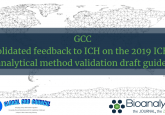ICH M10: History, publication and initial perspectives on global implementation

Differing bioanalytical method validation and sample analysis requirements among global health authorities have challenged the drug development process, causing inefficiencies and uncertainty.
In 2010, regional scientific associations began collaborating in earnest to discuss the challenges created by country-to-country differences. These inter-association discussions resulted in several publications that identified the need for a global bioanalytical guideline [1,2] and the creation of the Global Bioanalysis Consortium (GBC). Subject matter experts, including scientists from Labcorp Drug Development (NJ, USA), participated in the GBC to develop and publish harmonized best scientific practices.
From Bioanalytical Method Validation Guidance to ICH M10
In subsequent years, additional countries published their version or updated versions of their Bioanalytical Method Validation Guidance/Guidelines – adding to the complexity and sometimes conflicting expectations that bioanalysts had to fulfill to achieve compliance. In 2016, Japan’s Ministry of Health, Labour and Welfare (MHLW) and Pharmaceuticals and Medical Devices Agency (PMDA) submitted a request to the International Council for Harmonization of Technical Requirements for Pharmaceuticals for Human Use (ICH) Management Committee for a harmonized bioanalytical guidance. The ICH Management Committee accepted and published the M10 process concept paper in October 2016, and the Expert Working Group comprising ICH member country regulators, industry members and observers first met a month later.
Over the next three years, the Working Group met and considered the requirements for a global harmonized guideline; publishing a draft for public consultation in 2019. Labcorp Drug Development scientists participated in a number of regional organization activities, including the Chinese Bioanalysis Forum, European Bioanalysis Forum and American Association of Pharmaceutical Scientists, which developed and submitted comments to the Working Group. Unable to meet face-to-face during the COVID-19 restrictions, the Expert Working Group continued to meet virtually to review the public’s comments and recommendations on the draft Guideline. On May 24, 2022, the Expert Working Group was able to meet in Athens, Greece, where the regulatory members signed the final version of the guideline. ICH published that guideline, “Bioanalytical Method Validation and Study Sample Analysis”, on June 8, 2022.
Labcorp Drug Development has closely monitored the progress of the ICH M10 Expert Working Group and developed implementation plans to ensure compliance through the transition from regional guidelines to ICH M10. The Expert Working Group released a “Frequently Asked Questions” guide and is expected to release other training material over the next few months, and Labcorp Drug Development will continue to refine our plans based on any clarifying information in these new materials.
As a global provider of bioanalytical services, Labcorp’s globally harmonized standard operating procedures have been developed over a number of years to accommodate various regional regulations. Here, Labcorp Bioanalytical Services subject matter experts representing China, the European Union and the United States of America offer their perspectives on the impact of changing from current regional expectations to ICH M10.
ICH M10 in China
The National Medical Products Administration (NMPA; formerly known as the China Food and Drug Administration) has been engaging in significant regulatory reform over the past 10+ years. NMPA issued a series of guidance for bioanalysis to bring its regulations in line with international standards. In December 2011, China issued a guidance for clinical trial bioanalytical laboratory management. In 2015, the China Pharmacopeia issued a guidance for bioanalytical method validation, similar to U.S Food and Drug Administration (FDA) and EMA guidance, and it was updated in 2020 to reflect the latest regulatory requirements [3].
China joined ICH as a new Regulatory Member in May 2017. NMPA has implemented reforms to align China’s regulations with global standards adopting 361 guidance documents from ICH, FDA, EMA and World Health Organization (WHO). Chinese representatives joined the Expert Working Group (EWG) for the development of the ICH M10 Bioanalytical Method Validation Guideline. The NMPA Center of Drug Evaluation (CDE) ICH Working Group invited public consultation for the draft ICH M10 guideline in April 2019, receiving more than 100 comments, which were mostly from the China Bioanalysis Forum (CBF) and pharmaceutical industry companies in China.
There are two main types of clinical studies that require regulated bioanalysis support locally in China. First, to register a new drug in China, global pharma must conduct both a pharmacokinetic (PK) study and a Phase three study in a Chinese population. Global submissions require bioanalysis executed in China to be consistent with that executed in other regions. The new ICH M10 guideline is expected to harmonize expectations and streamline global drug development.
Second, when there is a Global Multi-Regional Clinical Trial (MRCT) with patients in China, Chinese bioanalysis is an essential part of the global trial. ICH M10 cross validation requirements to combine the data generated from different laboratories overcome differences in the current regional requirements with its harmonized approach:
- ICH M10 indicates cross validation is required to combine related data when multiple bioanalytical methods and/or bioanalytical laboratories are involved.
- ICH M10 suggests that if possible, cross validation should be assessed by measuring the same set of QCs at least in triplicate and study samples (if available) that span the study sample concentration range with both methods, or in both laboratories.
- ICH M10 recommends that bias can be assessed by Bland-Altman plots or Deming regression. Other methods appropriate for assessing agreement between two methods (e.g., concordance correlation coefficient) may be used as well. Alternatively, the concentration vs. time curves for study samples could be plotted for samples analyzed by each method to assess bias.
As a global service provider, we are looking forward to the full implementation of ICH M10 to streamline global drug development programs.
ICH M10 in the European Union
The current EMA guideline on bioanalytical method validation [4] became effective in February 2012, was the first to publish separate expectations for ligand binding assays (LBA); recognizing that they differ substantially from chromatographic analytical methods.
The scope of the EMA guideline is wide, providing ‘recommendations for the validation of bioanalytical methods applied to measure drug concentrations in biological matrices obtained in animal toxicokinetic studies and all phases of clinical trials’. Within ICH M10, the scope is more specifically defined to ‘nonclinical toxicokinetic (TK) studies conducted according to the principles of GLP, nonclinical PK studies conducted as surrogates for clinical studies, and all phases of clinical trials, including comparative bioavailability/bioequivalence (BA/BE) studies, in regulatory submissions’. ICH M10 also clarifies that full validation is expected for the primary matrix supporting the regulatory submission(s) and regulatory decisions regarding safety, efficacy or labelling; for evaluation of drug (and/or metabolites) levels in additional matrices, ICH M10 asks that assays are ‘validated as necessary’. This allows scientific freedom to validate according to the intended purpose of the data.
An area where there is a notable difference between the EMA guideline and ICH M10 is method development. The EMA guideline does not contain a dedicated section on method development, but does discuss assessments that would typically be performed during method development, such as (surrogate) matrix selection in cases where there are related endogenous compounds, and establishment of a minimum required dilution (MRD) for LBA. ICH M10 contains a dedicated section for method development, though it is limited to general considerations for establishing that a bioanalytical method is suitable for its intended purpose and ready for validation, and includes a statement that method development ‘does not require extensive record keeping or notation’.
There is an important difference between the EMA guideline and ICH M10 in the sections on cross-validation. Both EMA and M10 asks that the same set of quality control (QC) samples and/or study samples be analyzed with the different bioanalytical methods and/or by the different bioanalytical laboratories. However, EMA asks for a direct comparison of cross-validation results with a pass/fail approach, whereas ICH M10 does not contain any specific acceptance criteria for cross-validation and rather asks for analysis of any biases between methods or laboratories, which will allow more latitude to combine data from across platforms and/or laboratories providing that any identified biases are properly addressed.
For the majority of method validation assessments, such as selectivity, accuracy and precision, dilutional linearity, stability, there is little conflict between what is asked for in the EMA guideline and in ICH M10, the majority of differences being additional requirements in M10. In assessing selectivity for ligand binding assays, EMA asks for evaluation in 10 sources of sample matrix at or near the lower limit of quantitation (LLOQ), whereas ICH M10 recommends assessment at both LLOQ and high QC levels. For evaluation of dilutional linearity, ICH M10 asks for at least 3 independently prepared dilution series, whereas the number of preparations is not specified in the EMA guideline.
Perhaps the most impactful differences are found in expectations for assessment of analyte stability. ICH M10 states that for each concentration tested for stability, the bulk sample should be divided into a minimum of 3 aliquots that will be stored, stressed and analyzed. There is no such requirement to stress independent aliquots in the EMA guideline. The EMA guideline considers evaluation of analyte stability using the low and high QC levels of the assay sufficient, whereas ICH M10 will require evaluation of a higher concentration level stability QC sample(s) in cases where study sample concentrations are consistently higher than the ULOQ of the calibration curve.
There are also some welcome clarifications. For preparation of QC samples, EMA asks for at least 5 QC levels in LBA (anticipated LLOQ, less than 3 times the LLOQ, mid, high and anticipated upper limit of quantitation (ULOQ)), which has led to some ambiguity in expectations in the placement of the medium QC: some European agencies have accepted placement at the geometric mean, whilst others have insisted on placement around 30-50% of the calibration curve range, as stated in the chromatography section; ICH M10 brings harmonization in placement of the medium QC around the geometric mean of the calibration curve range.
ICH M10 in the USA
Two additions stand out in ICH M10 related to general principles that are not seen in the FDA 2018 guidance [5] and address animal use and clinical trial subject safety. With regard to animal use, M10 emphasizes developing ‘drugs in accordance with the principles of 3Rs – Reduce, Refine, Replace – for animal studies’. For clinical trial subjects, Good Clinical Practices have historically emphasized the safety of trial subjects and been applicable as part of bioanalysis. However, M10 takes the additional step of emphasizing that the reanalysis of “specific study samples for the purpose of a safety investigation” is acceptable.
A few notable changes from the FDA bioanalytical method validation (BMV) to the ICH M10 impact both ligand binding and chromatographic assay practices. For example, no QC rejection criteria for accuracy and precision (A&P) runs were established in the FDA BMV to allow the within and between run calculations to use the full data set. ICH M10 reverts to including acceptance criteria to QCs in A&P runs but requires all QCs to be included in within and between run calculations with the exceptions of QCs with documented analytical errors. Additionally, M10 also includes more extensive instruction for evaluation of lipemic and hemolyzed matrices, matrix effects and includes testing in relevant patient populations.
When considering therapies that are endogenous analytes, ICH M10 is much more prescriptive with many more details and sections than in the FDA BMV, including four sections on addressing calibration curves when there is no true blank matrix, approaches to preparing QCs, experimental design for selectivity, recovery and matrix effects, parallelism, stability, and accuracy and precision.
Additionally, ICH M10 addresses and clarifies multiple topics of current debate. The ICH M10 guideline states that stability determinations for bench top and/or autosampler stability are not to be conducted using an additive approach, but rather a single long duration test should be performed and reported. Stability at one facility can be used as representative of stability at another facility provided there is adequate data and documentation. Chromatographic assays stock solutions made prior to the expiration of the reference standard are considered valid and the stock solution stability is that established for the solution.
There are few differences around sample analysis practices for ICH M10 vs the FDA BMV. While conceptually similar, ICH M10 specifies QCs bracket study samples, whereas the FDA BMV described that QCs need only be interspersed with study samples. When considering incurred sample reanalysis (ISR), in the FDA BMV for clinical studies ISR was applicable to bioequivalence (BE) and pivotal pharmacokinetic or pharmacodynamic studies, whereas in ICH M10, the scope of ISR is expanded to BE, bioavailability (BA), first clinical trial, pivotal early patient trials and trials with patients with impaired hepatic and renal function. In both cases, the term pivotal is used and in the absence of clear definition may result in unneeded effort as sponsors take risk-adverse approaches.
Whilst FDA had already moved the needle to include additional reporting in 2018, ICH M10 went even further and includes a number of additional reporting content components. Many additional requirements for documentation and reporting are related to bioavailability (BA) and bioequivalence (BE) studies. Many additional details appear to be related to decreasing the need for on-site inspections and increased ease in detecting fraud for these pivotal studies. In addition to the report requirements, ICH M10 requires when BA or BE studies are in a filing that the sponsor include within Section 2.6.4/2.7.1 of the Common Technical Document details on regulatory inspections of the bioanalytical site in the 3 years prior to the study sample analysis and one-year post analysis.
Adhering to changing requirements
In conclusion, ICH M10 integrates the practices of health authority bioanalytical regulations from around the world into a single standard, making it much easier for bioanalytical work to be performed and meet global regulatory expectations. As this article was nearing completion, EMA published its adoption of ICH M10 with an effective date of January 21, 2023, establishing the first of many regional implementation dates. Labcorp Drug Development staff have been active in the discussions of harmonized global regulations for more than a decade and are prepared to deliver bioanalytical services that meet the new requirements of ICH M10.
References:
- van Amsterdam P, Lausecker B, Luedtke S, Timmerman P, Brudny-Kloeppel M. Towards harmonized regulations for bioanalysis: moving forward!. Bioanalysis. 2(4):689-91 (2010)
- Bansal SK, Arnold M, Garofolo F. International harmonization of bioanalytical guidance. Bioanalysis. 2(4):685-7 (2010)
- China Pharmacopeia. Guidance for Bioanalytical Method Validation (2020).
- Guideline on Bioanalytical Method Validation, European Medicines Agency, EMEA/CHMP/EWMP/EWP/192217/2009 Rev. 1 Corr. 2 (2011). https://www.ema.europa.eu/en/documents/scientific-guideline/guideline-bioanalytical-method-validation_en.pdf
- Bioanalytical Method Validation Guidance for Industry, U.S. Food and Drug Administration (2018). https://www.fda.gov/files/drugs/published/Bioanalytical-Method-Validation-Guidance-for-Industry.pdf






